Shed Foundations: 9 Solid Bases and How to Choose the Right One
If you've ever tried to find the "perfect" shed base, you'll know one thing right away: there isn't a one-size-fits-all solution. Some sheds sit on spongy grass. Others on rocky slopes. And then there are those monster sheds that weigh as much as a small car.
So before you reach for a bag of cement or click "buy" on a plastic grid base, it pays to step back and ask: What's my shed really going to sit on?
I've built sheds on more types of ground than I care to remember - from flat concrete pads to sloped gardens held back with retaining walls. And each situation needed something a little different.
That's why I put this guide together: to walk you through the 9 most reliable shed foundation types, explain when to use each one (and when not to), and link you to full how-to guides for every base.
Let's start with the most solid option of all...
Poured Concrete Shed Base: The Big One
1. Concrete shed base
Want your shed to feel like a house? A poured concrete base - often called a "raft" - is the go-to option.
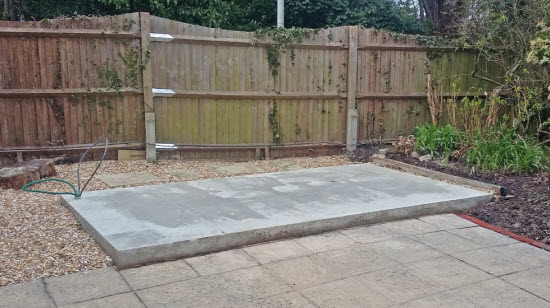 Completed concrete shed base before commencing shed construction
Completed concrete shed base before commencing shed construction
This is the heavy-duty choice. It's what I'd use for a workshop, a big garden office, or any shed that needs serious staying power. You can reinforce it with steel or keep it plain - either way, it gives you a rock-solid, level foundation that won't shift or sag over time.
Good for:
- Large, heavy sheds
- Permanent installations
- Areas with soft ground
Watch out for:
- Heavy work and curing time
- Higher material and labour cost
- It's not easily removable - this is a commitment
Read more:
How to build a concrete shed base
Using timber shed bearers to support your shed
Budget-Friendly Bases That Work
Not every shed needs to sit on a concrete slab. If you're building a lightweight garden shed or just want to keep costs down, these options can do the job nicely.
2.Plastic Grid Base
These are the lightweight honeycomb-style panels you can fill with gravel. Ideal for small sheds, they install quickly and provide decent drainage.
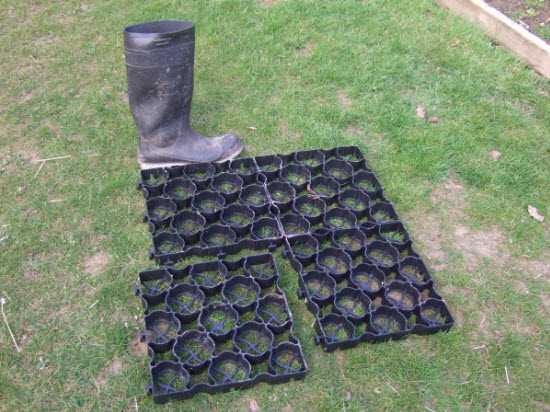 Interlocking plastic foundation grids
Interlocking plastic foundation grids
Good for:
- Small garden sheds
- Fast, dry installation
Watch out for:
- Needs a well-prepared surface
- Limited load-bearing capacity
Read more: Plastic shed foundations
3.Paving Slabs
A tried-and-tested option. Place them on a bed of sand and hardcore, level them off, and you're good to go. Still one of the best DIY solutions.
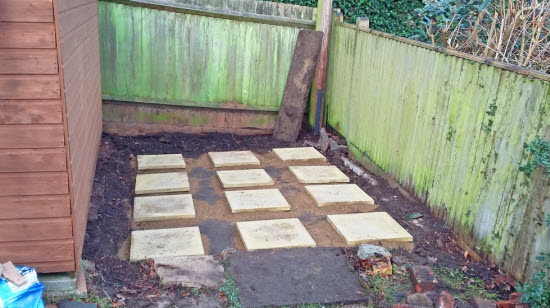 Shed foundation using concrete paving slabs
Shed foundation using concrete paving slabs
Good for:
- Medium sheds
- People on a budget
Watch out for:
- Precision levelling is key
- Not ideal on soft or shifting soil
Read more: Paving slab foundation
4.Timber Frame on Gravel
Make a wooden base (often with treated timber), lay it on gravel to allow for drainage, and secure your shed on top. It's quick and allows airflow underneath.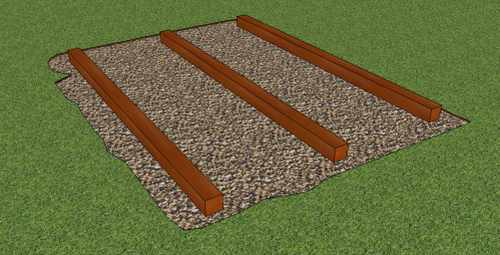 Building a shed foundation with timber bearers
Building a shed foundation with timber bearers
Good for:
- Temporary or moveable sheds
- Sites where you want to avoid concrete
Watch out for:
- Timber must be treated
- Keep an eye on long-term stability
Read more: Timber and stone foundation
Foundations for Sloping Sites: Holding Back the Hill
Got a garden with a slope? Don't worry. You don't have to dig out half the hill to get a level shed. Here are two clever ways to work with the land.
 Which option is best for you?
Which option is best for you?
5. Retaining Wall Base
Build a short retaining wall with concrete blocks or sleepers, backfill it with compacted material, and place your shed on top. Think of it like a terrace in your garden - one that just happens to support your new shed.
Good for:
- Steeper slopes
- Creating a usable, flat area
- Permanent garden features
Watch out for:
- Needs good drainage behind the wall
- More digging and block work required
Read more: Retaining wall foundation
6.Pier and Beam Foundations
This is the shed version of a stilt house. Concrete piers are set into the ground at key points, and a timber frame sits on top.
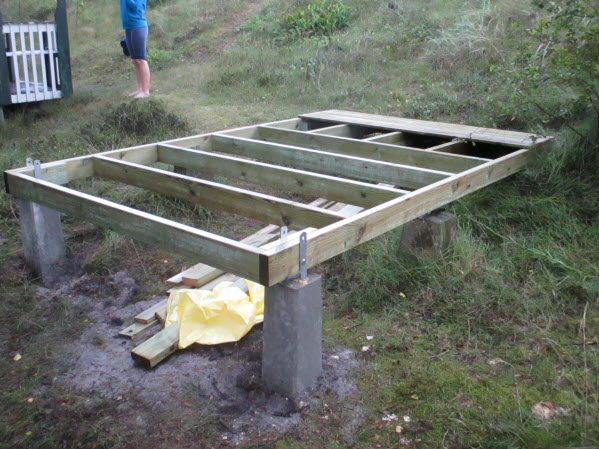 Shed pier foundation
Shed pier foundation
Good for:
- Sloped sites where you don't want to move lots of soil
- Minimal disturbance to roots or existing planting
Watch out for:
- Precision digging and levelling needed
- Requires accurate layout and beam work
Read more:
Find out more about the benefits of shed pier foundations
How to build a shed pier foundation
How to design your shed pier foundation
Adjustable Bases: Quick to Level, Easy to Move
I've built sheds in all sorts of places - half on patios, half on old footings, and sometimes just across a section of hardstanding where nothing is quite level. In situations like these adjustable base systems are invaluable
7.Adjustable plastic base: Simple, Reliable Support on Hard Ground
For most sheds built on patios, driveways, or other hard surfaces, I usually recommend a plastic base kit - specifically, the DryBoot shed bearer support. It lifts the floor just enough (20mm) to protect your timber from rising damp, improves ventilation underneath, and makes it easier to level the shed floor using spacers and shims.
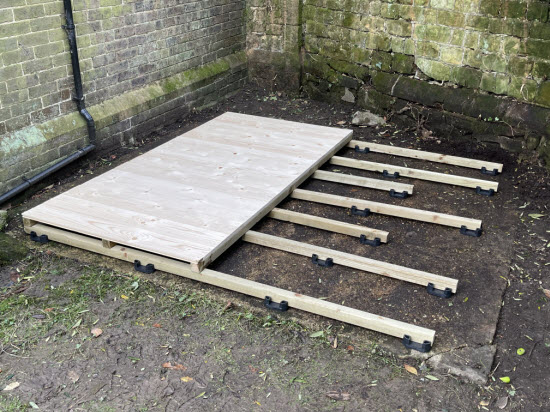 Dryboot supporting bearers with shed floor placed directly on top of bearers
Dryboot supporting bearers with shed floor placed directly on top of bearers
Good for:
- Sheds on solid, gently sloping hardstanding
- Quick installs without the need for fixings
- Keeping timber bearers dry and ventilated
Watch out for:
- Not suitable for very soft ground or steep slopes
- Bearers need to be well-aligned to distribute the load evenly
Read more: about how to use timber shed bearers
Read more: The Dry Boot shed foundation
8.Steel Adjustable Base: Level and Lift on Challenging Terrain
When the ground is really uneven or the shed is larger and heavier, I turn to a steel adjustable base system like the Quick Jack. It uses galvanised jacks to support a timber frame - you simply turn each one to raise or lower the height until the whole base is level.
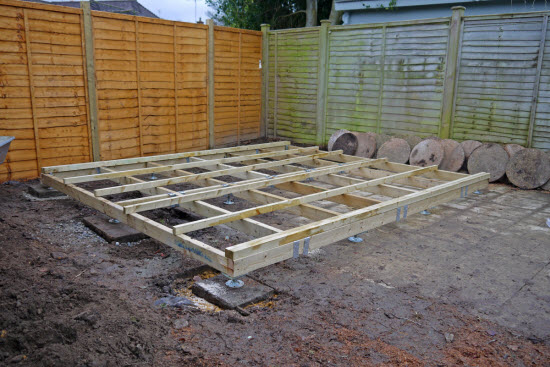 Adjustable shed foundation - metal jacks
Adjustable shed foundation - metal jacks
Good for:
- Mixed or uneven ground (e.g. part soil, part slab)
- Large or heavy sheds and summerhouses
- Creating excellent airflow and damp protection
Watch out for:
- Requires a bit more setup time and planning
- Costs more than simpler plastic base systems
Read more: Metal adjustable shed base
Bonus Tip:
If you're in an exposed area or worried about animals burrowing under your shed, a wire mesh around the base works wonders.
Ground Screw Base: The Pro Option for Tricky Sites
9.Ground screws
These are like giant steel screws that twist into the ground, forming instant foundation points. They're used for everything from decking to modular homes, and they work great for sheds too.
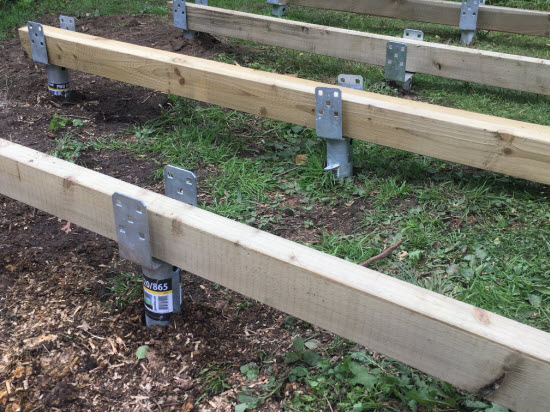 Close up of ground screw with timber bearers
Close up of ground screw with timber bearers
Good for:
- Uneven or soft ground
- Faster installs with minimal digging
Watch out for:
- You'll need specialist tools (or a contractor)
- Higher upfront cost, but excellent long-term value
- Hidden obstructions such as rock and services such as gas pipes and electricity cables
Read more: Ground screw foundations
Foundation FAQs: Clearing Up Common Questions
Q: How deep should my shed foundation be?
It depends on the type, but most lightweight sheds don't need deep footings. You just want to make sure the base is level and stable.
Q: Will my shed move or sink over time?
Only if the ground shifts beneath it. That's why proper preparation - especially good drainage and compacted material - is key.
Q: Do I need to anchor my shed to the base?
Yes, especially in windy areas. Most sheds have fixings that let you screw or bolt them to the base.
Final Thoughts: Build the Base that Works for Your Garden
There's no single "best" shed foundation. It all comes down to your soil, your slope, your shed - and how long you want it to last.
What matters most is choosing a foundation that matches your needs, and that you install it properly. Cut corners here, and you'll feel it every time it rains, the wind blows, or you open the door and find the floor's not quite level.
So take a few minutes to explore your options above, and check out the linked how-to guides. If you build the right foundation, you'll only have to do it once.

Keep in touch with our monthly newsletter
Shed Building Monthly




